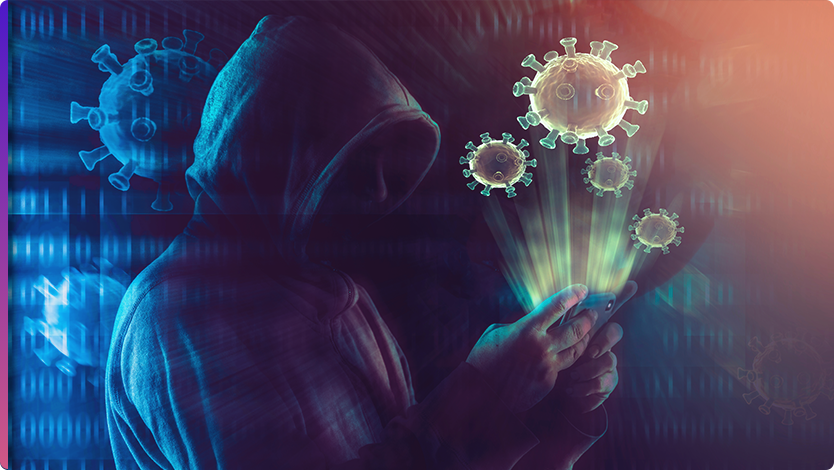
Barry had escaped the Covid virus for over 2 years. He’d been thrice vaxed, worked from home and thought he was immune. Restrictions were being lifted, he flew with doubled masks abroad, and then, on the train from Belfast, he must have encountered one carrier too many. Now he was forced to work and shop from within the confines of his home.
His computer was guarded by the latest anti-virus software; even his TV streamer used a VPN. But then he got phished.Coz, like medical viruses, online scammers wait till you’re relaxed and unsuspecting before they take advantage of your routine and convince you to click on an inauspicious Twitter link from your unassuming mobile phone.
A Lifestyle—Hacked!
Today’s pandemic has focused on people living in confined areas—the inner city, working in confined quarters—offices. How that has changed the way we live remains to be seen, as some of the habits we acquired are swiftly lost (like wearing masks), while others are adopted for continued living.
Without a doubt, Covid has slowed us down. As insufferable check-in lines make air travel intolerable, we have become less prone to accept traffic jams and other ills of the dynamic lifestyles we once took for granted. Online shopping has brought the already stricken retail sector to its knees, and theatrical releases have taken a clear back seat to streaming services, which providers are quick to price now as premium packages.
Most of us now work from home at least some of the week, and employers must now incentivize employees to come to those high-rent offices into which they have invested so much of their capital. Schools and academic institutions have had to get used to modern forms of teaching, finally abandoning habits born of the industrial revolution and before. We’ve become more attached to our home Wi-Fi networks than to outside cellular services and—of course—the old landlines that were once our lifelines to civilization.
But perhaps the biggest change has come from the financial sector. A trend that reaches as far back as the invention of NASDAQ’s electronic trading system now has most of us paying by app, banking by apps, and watching closely as cryptocurrencies transition from being a quirk to a national currency—as in Estonia and soon, China.
In the space of two years, we have put our trust in those handheld devices to enter our bank accounts, execute transfers, and even click to pay using Google or Apple pay, Payoneer, Stripe, and Revolut—the last of which has now become a bank in its own right. Credit cards have become almost obsolete, and the ease of hacking our cellphones is something we banish from our minds.
Going Phishing
On the other side of the equation come the advertisers—those who actually pay for the heads and eyes now being attracted to a new channel of communications—the smartphone, which needs neither a cinema hall nor a living room or study. It goes everywhere. They can almost plug into their demo’s heads and follow them everywhere.
And yet, an interesting phenomenon occurs during times of stress: fight or flight—the normal human reaction to a threat. As the Corona pandemic began, people began using their phones more to update, then—as they were inundated with information, as they began to pick up information for themselves, usage dropped. But a new lifestyle was emerging due to the requirements of self-preservation: a regression into nuclear families and the individual—one that required an adaption of needs to the means available. Information exchange took a back seat to services apps—online banking, schooling, remote working, etc.
Now, the ground was set for the hackers. For if the exchange of information is bi-polar—information broadcaster and information recipient—the exchange of services is from a centralized service provider to many service consumers, a golden opportunity for exploitation. The service provider will usually have a website that can be duplicated.
Masks and Philters
Phishing hackers simply duplicate a website asking for user information. Then, rather than using that information for the user’s benefit, they use it to infiltrate the user’s private accounts—banking, utilities, workplace, etc. Once in, they can either exploit the hacked user’s personal data or—in more sophisticated attacks—infiltrate the entire system even deeper, using the client as a gateway. Thus, bank accounts can be emptied, in the lesser case, and entire electricity grids shut down, in the latter.
Thus, no less than in the original Covid 19 pandemic, the individual is now tasked with further caution. Just as we got used to social distancing and wearing masks to protect against Covid, now we must think before we enter a website. Suddenly, instead of clicking on a link as naturally as we breathe, we must now examine the sender—is he/she legitimate? Is there anything suspicious about the URL we are being sent to? Is it a phishing site? Are we about to be hacked?
In order to minimize the hindrance, institutional systems are being protected by extended cybersecurity systems that enable entrance only to vetted websites. These systems consider mobile devices as mere endpoints to the wider enterprise system. However, similar systems are now being offered for individual mobile phones that compare a URL to a bank of known phishing sites—thousands of which appear each day!
Soon they will be standard fare—as ubiquitous as facial masks.





